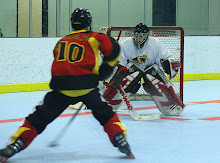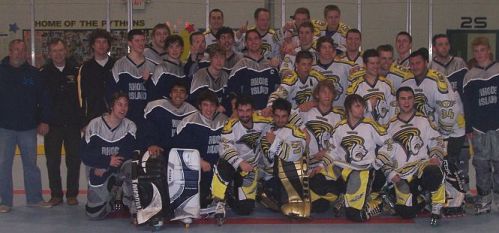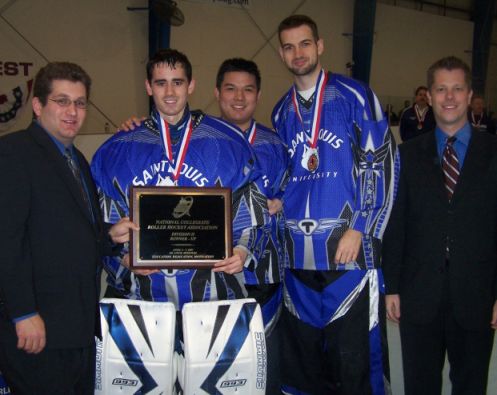Thursday, April 17, 2008
2008 - Division I All-American Team
First Team:
Charlie Middleton - UC Irvine
PJ Tallo - UMSL
Ryan Cowdell - Towson
Mike Tasch - UC Irvine
G-James Cash - UMSL
Second Team:
Ryan Burrows - Long Beach State
Jim Tamburino - Stony Brook
Kyle Gouge - Lindenwood
Tyler Wasler - Buffalo
G-Dustin Brown - Lindenwood
Honorable Mention:
Brandon Barnette, Lindenwood
Adam Clarke - UMSL
Jason Deskins - Eastern Michigan
Tony Ascenzo - Michigan State
G-Richie Latona - Buffalo
Charlie Middleton - UC Irvine
PJ Tallo - UMSL
Ryan Cowdell - Towson
Mike Tasch - UC Irvine
G-James Cash - UMSL
Second Team:
Ryan Burrows - Long Beach State
Jim Tamburino - Stony Brook
Kyle Gouge - Lindenwood
Tyler Wasler - Buffalo
G-Dustin Brown - Lindenwood
Honorable Mention:
Brandon Barnette, Lindenwood
Adam Clarke - UMSL
Jason Deskins - Eastern Michigan
Tony Ascenzo - Michigan State
G-Richie Latona - Buffalo
2008 - Division II All-American Team
First Team:
Christian Bernad - CSUSB
Jon Donohue - Neumann
Tim Saraceni - West Chester
Kenny McCubbins - UCSD
G-Sean Yingling - Neumann
Second Team:
Ryan Weeks - Elon
Tom Cavanaugh - Shippensburg
Victor Scotto - Neumann
Dane Moody - Truman State
G-Adrian Gonzalez - Cal Poly Pomona
Honorable Mention:
Steve Klenk - Neumann
Erick Rivas - Cal Poly Pomona
Jim Dougherty - Truman State
Andrew Wiltz - Saint Louis
G-Dan Hogan - West Chester
Christian Bernad - CSUSB
Jon Donohue - Neumann
Tim Saraceni - West Chester
Kenny McCubbins - UCSD
G-Sean Yingling - Neumann
Second Team:
Ryan Weeks - Elon
Tom Cavanaugh - Shippensburg
Victor Scotto - Neumann
Dane Moody - Truman State
G-Adrian Gonzalez - Cal Poly Pomona
Honorable Mention:
Steve Klenk - Neumann
Erick Rivas - Cal Poly Pomona
Jim Dougherty - Truman State
Andrew Wiltz - Saint Louis
G-Dan Hogan - West Chester
2008 - Division III All-American Team
First Team:
Gus Maloney - St. Charles
Jason Yokubison - Oakland
Blake Johnson - Broward
Craig Crow - Red Rocks
G-Robbie Richter - Broward
Second Team:
Miles Cook - Red Rocks
Chris Sandoval - Arapahoe
Max Stern - Suffolk
Nick Wolfer - Nassau
G-Adam Weeks - Nassau
Honorable Mention:
Michael Marrero - Broward
Scott Johnson - Broward
Jordan Freeborn - Broward
Rowan Porter - Nassau
G-Danny Bara - Oakland
Gus Maloney - St. Charles
Jason Yokubison - Oakland
Blake Johnson - Broward
Craig Crow - Red Rocks
G-Robbie Richter - Broward
Second Team:
Miles Cook - Red Rocks
Chris Sandoval - Arapahoe
Max Stern - Suffolk
Nick Wolfer - Nassau
G-Adam Weeks - Nassau
Honorable Mention:
Michael Marrero - Broward
Scott Johnson - Broward
Jordan Freeborn - Broward
Rowan Porter - Nassau
G-Danny Bara - Oakland
2008 - B Division All-American Team
The IRC is proud to announce the 2008 IRC B-Division All-American Team:
First Team:
Brian Costello - Cal Poly SLO
Eric Byrnes - Michigan State
Tim Grossmann - Michigan
Jeff Elias - Buffalo
G-Jay Schoen - UCSB
Second Team:
Alex Nebrig - UMSL
Patrick Fuist - Lindenwood
Dave Majewski - Eastern Michigan
Jeff Mobley - Lindenwood
G-Jared Moore - Lindenwood
Honorable Mention:
Scott Wilson - Cal Poly SLO
Chris Stevenson - Penn State
Max Zastrow - Colorado State
Tim Newbold - Buffalo
G-Michael Caliguri - Michigan State
First Team:
Brian Costello - Cal Poly SLO
Eric Byrnes - Michigan State
Tim Grossmann - Michigan
Jeff Elias - Buffalo
G-Jay Schoen - UCSB
Second Team:
Alex Nebrig - UMSL
Patrick Fuist - Lindenwood
Dave Majewski - Eastern Michigan
Jeff Mobley - Lindenwood
G-Jared Moore - Lindenwood
Honorable Mention:
Scott Wilson - Cal Poly SLO
Chris Stevenson - Penn State
Max Zastrow - Colorado State
Tim Newbold - Buffalo
G-Michael Caliguri - Michigan State
Subscribe to:
Comments (Atom)
The Rankings Explained
Since the conclusion of the season both founders set out to find the best solution to answer the age old question, “Who’s #1?” After much search, the answer was to use a mathematical formula to calculate the answer. Removing the human element from the voting would likely result in less biased rankings towards individual teams and regions.
The solution would be found in the ELO chess rating system. They system was created to rank chess players by another means that wins, losses and draws. The system uses a mathematical formula to reward each person for impressive feats and punish them for lesser impressive feats. Because chess and inline hockey are two different animals, the general equation had to be changed to allow for more hockeys related factors into the equation.
Using the FIFA Women’s World Rankings as a guideline (Elo Based), we managed to change the rankings to suit the nature of our sport. The rankings include the importance of the game, the outcome of the game, the expected result of the game, and the goal differential of the game when calculating a result. To better explain the way the rankings work I give you the following examples (all team start with a ranking of 1500):
Lindenwood University (1500) vs. UMSL (1500): If Lindenwood won the regular season game 4-3; they would be awarded 15 points for the victory and UMSL would be docked 15 points. However, if the game was won 12-2, Lindenwood would earn 39.38 points for the victory and UMSL would be docked 39.38 points. Additionally, the importance of the game could change, using the national title game as the example, with both teams having equal ratings Lindenwood would be awarded 52.5 points for a 6-3 win.
However, as you could assume, two teams having the same rating would be rare. Each teams point total carries over from one week to the next and from one season to the next. The following is a example of two teams with different point values and the different results it can produce.
Lindenwood University (1746.38) vs. Illinois State (1360.88): There are a few things that you can determine because of the vast difference in each teams rating (385.5). The first is that Lindenwood is expected to win the game. The second is that Illinois State winning the game would be a much bigger accomplishment that Lindenwood winning the game. The maximum points Lindenwood can earn from this game is 7.72, which would mean they won by at least 10 goals. However, on the flip side, if Illinois State was to win the game by at least 10 goals they could earn as many as 71.03 points. This is based on the projection that Lindenwood would win the match-up 90% of the time.
As the two examples show, there are a bunch of positives when using this system. For starters, once a team has achieved a high rating, it becomes difficult for them to increase it without playing a higher level of competition. This rewards regions that have more competitive teams. It also rewards teams who travel out of the region and win games against other higher rated teams. For example, last season, Towson and Army both played James Madison who would have had a higher rating that both visiting teams. In the games, Army and Towson both won handily and would have increased their ratings while negatively hurting James Madison. But, the hidden bonus is they now can bring those rating points back into their region. Those points then become spread out over the entire region as the season progresses and teams win and lose.
For the ratings system to work, each game has to have a certain amount of value attached to it. In the system we will be using five different levels to rate the importance of any give game. The first level is the lowest level of importance; it contains all pre-season exhibition games. The second level includes all regular-season regional games, as well as cross-divisional exhibition games. Level three includes all cross-regional games and invitational based tournaments, like WinterFest. The fourth level includes all regional playoff games and the fifth and final level includes all national playoff games.
The solution would be found in the ELO chess rating system. They system was created to rank chess players by another means that wins, losses and draws. The system uses a mathematical formula to reward each person for impressive feats and punish them for lesser impressive feats. Because chess and inline hockey are two different animals, the general equation had to be changed to allow for more hockeys related factors into the equation.
Using the FIFA Women’s World Rankings as a guideline (Elo Based), we managed to change the rankings to suit the nature of our sport. The rankings include the importance of the game, the outcome of the game, the expected result of the game, and the goal differential of the game when calculating a result. To better explain the way the rankings work I give you the following examples (all team start with a ranking of 1500):
Lindenwood University (1500) vs. UMSL (1500): If Lindenwood won the regular season game 4-3; they would be awarded 15 points for the victory and UMSL would be docked 15 points. However, if the game was won 12-2, Lindenwood would earn 39.38 points for the victory and UMSL would be docked 39.38 points. Additionally, the importance of the game could change, using the national title game as the example, with both teams having equal ratings Lindenwood would be awarded 52.5 points for a 6-3 win.
However, as you could assume, two teams having the same rating would be rare. Each teams point total carries over from one week to the next and from one season to the next. The following is a example of two teams with different point values and the different results it can produce.
Lindenwood University (1746.38) vs. Illinois State (1360.88): There are a few things that you can determine because of the vast difference in each teams rating (385.5). The first is that Lindenwood is expected to win the game. The second is that Illinois State winning the game would be a much bigger accomplishment that Lindenwood winning the game. The maximum points Lindenwood can earn from this game is 7.72, which would mean they won by at least 10 goals. However, on the flip side, if Illinois State was to win the game by at least 10 goals they could earn as many as 71.03 points. This is based on the projection that Lindenwood would win the match-up 90% of the time.
As the two examples show, there are a bunch of positives when using this system. For starters, once a team has achieved a high rating, it becomes difficult for them to increase it without playing a higher level of competition. This rewards regions that have more competitive teams. It also rewards teams who travel out of the region and win games against other higher rated teams. For example, last season, Towson and Army both played James Madison who would have had a higher rating that both visiting teams. In the games, Army and Towson both won handily and would have increased their ratings while negatively hurting James Madison. But, the hidden bonus is they now can bring those rating points back into their region. Those points then become spread out over the entire region as the season progresses and teams win and lose.
For the ratings system to work, each game has to have a certain amount of value attached to it. In the system we will be using five different levels to rate the importance of any give game. The first level is the lowest level of importance; it contains all pre-season exhibition games. The second level includes all regular-season regional games, as well as cross-divisional exhibition games. Level three includes all cross-regional games and invitational based tournaments, like WinterFest. The fourth level includes all regional playoff games and the fifth and final level includes all national playoff games.









